There’s nothing like walking home from work and the house smelling absolutely delicious; of course, that usually means dinner is being made, but what if you could have that delicious smell all day long? No, we aren’t burning dinner; we are using simmer pots to naturally scent our home without toxic fragrances!
Simmer pots, sometimes called stovetop potpourri, are simple combinations of everyday kitchen ingredients added to a pot of water. The best part about simmer pots is there are no measurements; it’s usually just using what you have. It’s as simple as bringing the water to a boil before reducing it to a low simmer. As the water evaporates, it naturally aromatizes your home (and adds moisture to dry air). These are especially fun to utilize in the spicy scents of the fall and winter seasons.
Of course, the aroma could have various benefits depending on what ingredients you add. So, let’s discuss some ingredients you can add, and then, in the end, we will have recipes! If you’re looking for more recipes, Earthley’s guide, The Clean Home Project, has a few I have enjoyed.
Ingredients to Add to Simmer Pots
Apples and their seed components have antioxidant and antimicrobial activities (1). Apples are also a great source of quercetin (2). Studies suggest quercetin may be a suitable treatment for allergic inflammatory diseases like asthma and sinusitis (3). Since inhaling quercetin flavonoids allows the drug to reach the lungs directly (4), we can only assume the same is possible when inhaling an apple’s aroma.
Cinnamon or cinnamon sticks are a great addition to any simmer pot thanks to their antibacterial, antifungal, and antiviral properties (5,6,7). Test-tube studies suggest that cinnamon could help kill certain fungi, especially those that cause respiratory tract infections (8). Remember, there are two common types of cinnamon: cassia and Ceylon. Although cassia cinnamon is the most common variety, Ceylon cinnamon is known as “true” cinnamon (9). Check out our blog, Cassia Cinnamon Vs. Ceylon Cinnamon.
Clove or clove buds, not to be confused with clove essential oil (the difference is explained in our blog When & Why to Choose Clove Vs. Clove Essential Oil), have antioxidant and antibacterial properties (10,11). Clove’s medicinal properties stem from compounds like eugenol, eugenol acetate, and gallic acid, with powerful pharmaceutical-like effects (12). For instance, Eugenal is well recognized for its antimicrobial, anticancer, antioxidant, anti-inflammatory, and analgesic properties and is even found in pharmaceuticals (13).
Eucalyptus has antimicrobial and antifungal properties (14,15). Eucalyptus also has anti-inflammatory properties (16), and research demonstrates that the anti-inflammatory properties can decrease mucus and expand the bronchi and bronchioles of your lungs (17). Adding eucalyptus to a simmer pot could provide great respiratory support, similar to diffusing eucalyptus essential oil.
Grapefruit, especially grapefruit peel, is a great source of natural bioactive flavonoids with outstanding antioxidant activity, which can be used as agents in several therapeutic strategies (18). Citrus containing the same compounds as grapefruit has been linked to having a calming and anti-anxiety effect (19). When grapefruit is used in a simmering pot, these benefits may occur through the vapors released.
Lavender is often used for anxiety relief as it has a sedative-like effect. Studies have shown that lavender oil can positively affect symptoms associated with anxiety. One study found that lavender oil was equivalent to lorazepam in its starting dose in patients with subsyndromal anxiety (20). The inhalation of lavender oil has been found to influence vital signs and anxiety (21), so these effects may occur when used in a simmering pot.
Lemon or lemon peels are often discarded, but studies have determined that lemon peel is full of bioactive compounds that may provide numerous health benefits. Lemon peels have antibacterial, antimicrobial, and antifungal properties (22,23,24). In vitro studies determined lemon peels had more robust antioxidant activities than grapefruit or tangerine peels (25). Other studies have found lemon peel to significantly impair and reduce the growth of antibiotic-resistant bacteria (26). Adding lemon or lemon peel to a simmer pot would smell amazing and help clean the air.
Orange, especially orange peel, is a good source of the polyphenols hesperidin and polymethoxyflavones (PMFs), which have been studied for their potential anticancer effects (27,28,29). Oranges also have antimicrobial and antifungal properties (30,31). When orange essential oil is diffused, it can reduce symptoms of depression and anxiety (32,33); these benefits may also occur from the vapors of a simmering pot with oranges.
Pine, especially pine needles, are brimming with health benefits. Pine needles have antimicrobial and antifungal properties (34,35). Studies have found that pine needles have antiviral properties strong enough to prevent influenza (36). Studies have also found that inhaling pine improves airway function (37), which makes it a great addition to any simmer pot recipe.
Rosemary has antioxidant, antimicrobial, and anti-inflammatory properties (38,39,40). Many studies have been conducted around the possibility that rosemary may improve mood, memory, and overall brain health (41,42,43). These effects may occur from the vapors released when added to a simmer pot.
Sage contains chlorogenic acid, caffeic acid, rosmarinic acid, ellagic acid, and rutin (44), all linked to pharmacological properties, such as a lower risk of cancer and improved brain function and memory (45). Sage also has antibacterial, antiviral, and antifungal properties (46), making it a great addition to a simmer pot, especially for cleaning the air.
Star anise has many health-promoting compounds, such as linalool, quercetin, anethole, shikimic acid, gallic acid, and limonene, responsible for its antioxidant, anti-inflammatory properties, and antimicrobial properties (47,48,49). Star anise also has antifungal and antiviral properties (50,51), making it an excellent choice for a simmer pot.
Ultimate Simmer Pot Collection
Apple Spice Simmer Pot Ingredients:
- Sliced lemons
- Sliced apples
- Cloves
- Cinnamon sticks
- Water
Pumpkin Spice Simmer Pot Ingredients:
- Pumpkin puree
- Cinnamon sticks
- Pumpkin spice seasoning
- Water (to cover)
Directions:
Step 1: Gather and combine all the ingredients in a stove or crockpot.
Step 2: Simmer on low and enjoy the blissful aroma of a simmer pot!







